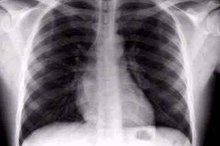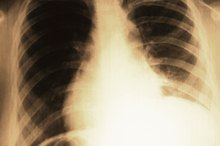What does fact checked mean?
At Healthfully, we strive to deliver objective content that is accurate and up-to-date. Our team periodically reviews articles in order to ensure content quality. The sources cited below consist of evidence from peer-reviewed journals, prominent medical organizations, academic associations, and government data.
The information contained on this site is for informational purposes only, and should not be used as a substitute for the advice of a professional health care provider. Please check with the appropriate physician regarding health questions and concerns. Although we strive to deliver accurate and up-to-date information, no guarantee to that effect is made.
What Is Mild Hyperinflation?
The term “hyperinflation” can refer to either money, when inflation rises uncontrollably, or to a medical condition of the lungs when they are abnormally expanded 1. However, “mild hyperinflation” can refer only to overinflated lungs, as monetary hyperinflation is by definition out of control and never mild 1. While “static hyperinflation” and “dynamic hyperinflation” are the official medical terms describing types of hyperinflation, “mild hyperinflation” is a non-technical way of describing the appearance of unusually inflated lungs 1.
If you are experiencing serious medical symptoms, seek emergency treatment immediately.
Appearance
Lungs can appear hyperinflated in a chest X-ray without truly being so. For example, older men with osteoarthritis can have lungs that look overly inflated because of what the disease has done to the bones of their ribs. Also, just taking a deep breath and holding it can make the lungs look mildly hyperinflated. The most notable symptom of hyperinflation, difficulty breathing, can be caused by many things aside from hyperinflation, from taking a jog to catching a cold 1.
- Lungs can appear hyperinflated in a chest X-ray without truly being so.
- The most notable symptom of hyperinflation, difficulty breathing, can be caused by many things aside from hyperinflation, from taking a jog to catching a cold 1.
Diagnosis
Heavy Breathing During Exercise
Learn More
A chest X-ray is the first step toward diagnosing mild (or any type of) hyperinflation 1. However, as noted above, the appearance of hyperinflated lungs is not necessarily hyperinflation 1. If you appear to have hyperinflation in your X-ray, the next step is to see a lung specialist for a lung function test 1.
Hyperinflation Means...
If the lung function test results are abnormal, the lung specialist will examine you and come to a diagnosis, as static and dynamic hyperinflation are only symptoms of greater illnesses 1. Emphysema, lung cancer, asthma and chronic obstructive pulmonary disease are all possibilities.
Less Serious Cases
How to Strengthen Your Lungs
Learn More
Although hyperinflation can mean something serious, mild hyperinflation can also just be a side effect of non-lethal lung conditions 1. Asthma, chronic smoking or a virus can trap air in the lungs, causing them to hyperinflate. Although none of these things are healthy, they’re not deadly either and will often result in difficulty breathing with no further problems. Still, a person who experiences regular difficulty breathing would be wise to visit a lung specialist to check for anything serious. If nothing else, asthma that causes difficulty breathing is probably poorly controlled and a smoking habit that affects your breathing is likely to lead to emphysema in the long run.
- Although hyperinflation can mean something serious, mild hyperinflation can also just be a side effect of non-lethal lung conditions 1.
- If nothing else, asthma that causes difficulty breathing is probably poorly controlled and a smoking habit that affects your breathing is likely to lead to emphysema in the long run.
Related Articles
References
- Investopedia; Hyperinflation
- AJRCCM Podcasts; Why Does the Lung Hyperinflate?
- Mayo Clinic; Emphysema
- MedHelp; Respiratory Disorders
- Xu Y, Yamashiro T, Moriya H, et al. Hyperinflated lungs compress the heart during expiration in COPD patients: a new finding on dynamic-ventilation computed tomography. Int J Chron Obstruct Pulmon Dis. 2017;12:3123-31. doi:10.2147/COPD.S145599
- Hui S, How CH, Tee A. Does this patient really have chronic obstructive pulmonary disease?. Singapore Med J. 2015;56(4):194-6. doi:10.11622/smedj.2015058
- Pompeo E. Lung Volume Reduction Surgery for Emphysema Treatment: State-of-the-Art and Perspectives. ISRN Pulmonol. 2014;2014:418092. doi:10.1155/2014/418092
- Milenkovic B, Janjic SD, Popevic S. Review of lung sealant technologies for lung volume reduction in pulmonary disease. Med Devices (Auckl). 2018 Jun;11:225-31. doi:10.2147/MDER.S127136
- Rossi A, Aisanov Z, Avdeev S, et al. Mechanisms, assessment and therapeutic implications of lung hyperinflation in COPD. Respir Med. 2015 Jul;109(7):785-802. doi:10.1016/j.rmed.2015.03.010
- Struß N, Bauersachs J, Welte T, Hohlfeld JM. Left heart function in COPD : Impact of lung deflation. Herz. 2019 Sep;44(6):477-82. doi:10.1007/s00059-019-4816-5
Writer Bio
Elizabeth Reuter was first published in her high school's creative writing magazine in 1999. She then moved on to professional articles for venues such as Guadalajara's "Lost Ojos del Lagos" and the Post-Feminist Playground website. Reuter earned her Bachelor of Arts in international studies from St. Mary's College.









